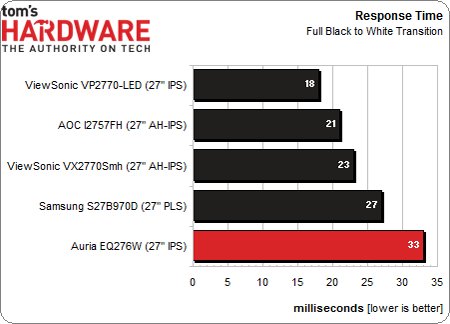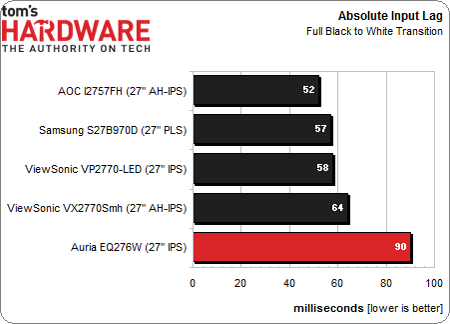Auria EQ276W 27" IPS Monitor Review: QHD For $400
Although QHD screens are nothing new, they remain atop the desktop monitor price ladder. Auria broke the $400 barrier with its new EQ276W 27” IPS panel. Today, we run it through our display benchmarks to see how it compares to far pricier competition.
Results: Pixel Response And Input Lag
To perform these tests, we use a high-speed camera that shoots at 1,000 frames per second. Analyzing the video frame-by-frame allows us to observe the exact time it takes to go from a zero-percent signal to a 100% white field.
The pattern generator is placed at the base of the monitor so our camera can capture the precise moment its front-panel LED lights up, indicating that a video signal is being received by the monitor. With this camera placement, we can easily see how long it takes to fully display a pattern after pressing the button on the generator’s remote. This testing methodology allows for accurate and repeatable results when comparing panels.
The EQ276W trails the pack by six milliseconds in the screen draw measurement. This might not be the best monitor for the hardcore gamer with super-human reflexes, though it’s still fast enough to eliminate motion blur in video content.
Let’s see if the input lag helps the overall numbers at all.
With a total lag time of 90 milliseconds, the Auria is the slowest-responding IPS monitor we’ve tested recently. How this will affect gaming depends on the user. Most would be satisfied with this level of performance, but the more hardcore players will want something a little speedier.
Get Tom's Hardware's best news and in-depth reviews, straight to your inbox.
Current page: Results: Pixel Response And Input Lag
Prev Page Results: Viewing Angle And Uniformity Next Page Too Good To Be True, Or Just Good Value?
Christian Eberle is a Contributing Editor for Tom's Hardware US. He's a veteran reviewer of A/V equipment, specializing in monitors. Christian began his obsession with tech when he built his first PC in 1991, a 286 running DOS 3.0 at a blazing 12MHz. In 2006, he undertook training from the Imaging Science Foundation in video calibration and testing and thus started a passion for precise imaging that persists to this day. He is also a professional musician with a degree from the New England Conservatory as a classical bassoonist which he used to good effect as a performer with the West Point Army Band from 1987 to 2013. He enjoys watching movies and listening to high-end audio in his custom-built home theater and can be seen riding trails near his home on a race-ready ICE VTX recumbent trike. Christian enjoys the endless summer in Florida where he lives with his wife and Chihuahua and plays with orchestras around the state.
-
techbaddie I love My Auria, I also did buy a another stand for it. It was $29.99 on Amazon, and once I got everything set up, IT IS AMAZING!!!!! If you want a great product for the right price, DO IT!Reply -
BigMack70One important thing to mention that you guys didn't that I believe still holds true (haven't checked the competition in a couple months - someone correct me if I'm wrong here): this is the only model of this panel (as opposed to the Catleaps/Crossovers/Overloards/Achievas/etc) to have HDCP support. If you want one of these panels and you want to use HDCP protected content (a games console or a Blu-ray player, for example), you NEED to purchase this Auria and not one of the other versions of the panel.I have the Achieva Shimian that was purchased three months ago. I checked on Nvidia Settings and it states that "This display supports HDCP."Reply
Happy that this article was posted and I been very happy with my purchase.
As for lag, i heard from "razetheworld" that when the monitor has one connector (usually DVI) the input lag can be as low as 6ms on these IPS screens. When there are multiple connectors like the monitor being reviewed here, higher lags are expected because the monitor takes time to process which connection is in use. I may be wrong, so correct me if i am wrong. -
chumly There are 3 models available from an American company based in California called Overlord Computer, one of these models can be overclocked to 120 Hz. I would like to see these monitors tested. One of them is priced under $400.Reply -
patrick47018 chumlyThere are 3 models available from an American company based in California called Overlord Computer, one of these models can be overclocked to 120 Hz. I would like to see these monitors tested. One of them is priced under $400.Reply
While this is true, MicroCenter has a great return policy, I'm not sure about Overlord, but I do know the one that is under 400, its 384, only has DVI, while this has HDMI, DisplayPort, DVI, headphon jack, and VGA. So if you just want DVI, getting an Achieva Shimian is cheaper off of ebay, but then also you have to deal with possible shoddy return system. Good luck to all and I will comment once I have my Auria, I'm going from my 40" Auria 1080P HDTV to a Auria 27" 1440P IPS monitor, good trade I think. -
chumly patrick47018While this is true, MicroCenter has a great return policy, I'm not sure about Overlord, but I do know the one that is under 400, its 384, only has DVI, while this has HDMI, DisplayPort, DVI, headphon jack, and VGA. So if you just want DVI, getting an Achieva Shimian is cheaper off of ebay, but then also you have to deal with possible shoddy return system. Good luck to all and I will comment once I have my Auria, I'm going from my 40" Auria 1080P HDTV to a Auria 27" 1440P IPS monitor, good trade I think.Reply
Most video cards have Dual link DVI so this isn't really an issue unless yours does not. I use a Catleap Q270 monitor right now (let me tell you, there is NO going back for me after getting one of these, 1080p monitors are as good as yesterday's trash to me). This was a B grade panel and it ended up having no visable defects or bad pixels (I only paid $245 for it off of ebay new from Korea, they've gone up $100 since). The reason I ended up going with the panel I did was from a quite extensive post on hardforum detailing how the DVI-only monitors were having incredibly low input lag compared to any of the other 1440p IPS panels available. I'm getting incredible framerates with my 670 and my games are streak/ghost/stutter/tearing free.
Maybe this Auria monitor just can't hack it vs. its' Korean counterparts.
Also it's good to know you can always take apart these monitors and replace the PCB so that you can overclock them to 120Hz, but Overlord is the only place selling the part and it's $200 :( -
cats_Paw Minimum contrast ratio in samsung 4003.3. Maximum Contrast Ratio in Samsung 1483.83.Reply
Is it me or thats not normal? -
ceberle Reply10608531 said:Minimum contrast ratio in samsung 4003.3. Maximum Contrast Ratio in Samsung 1483.83.
Is it me or thats not normal?
Minimum and maximum refer to the brightness setting. It's not unusual for the contrast ratio to go up when the brightness is lowered. In the case of the Samsung S27B970D, the black level dropped by a greater percentage than the peak white level; hence the higher contrast ratio.
Christian

